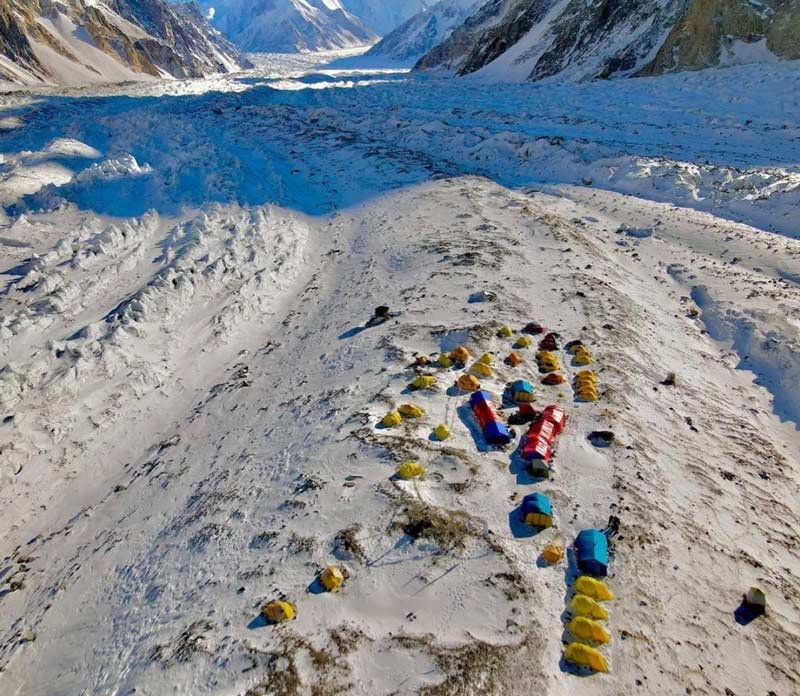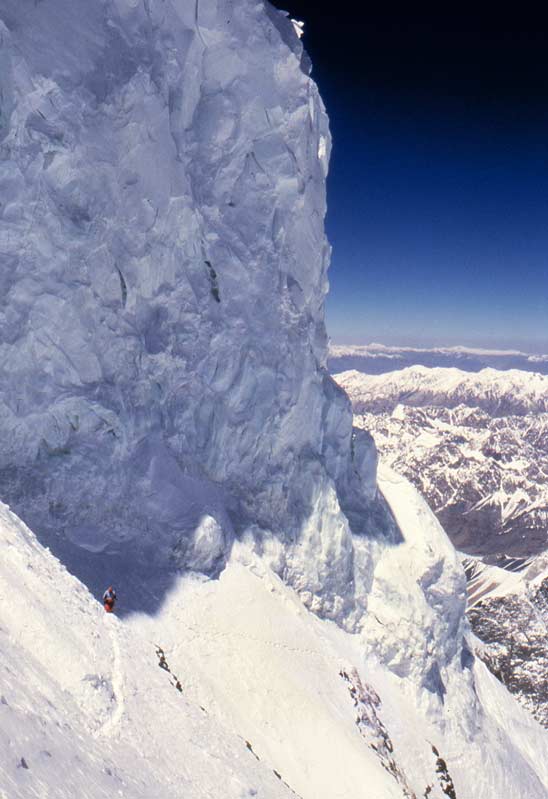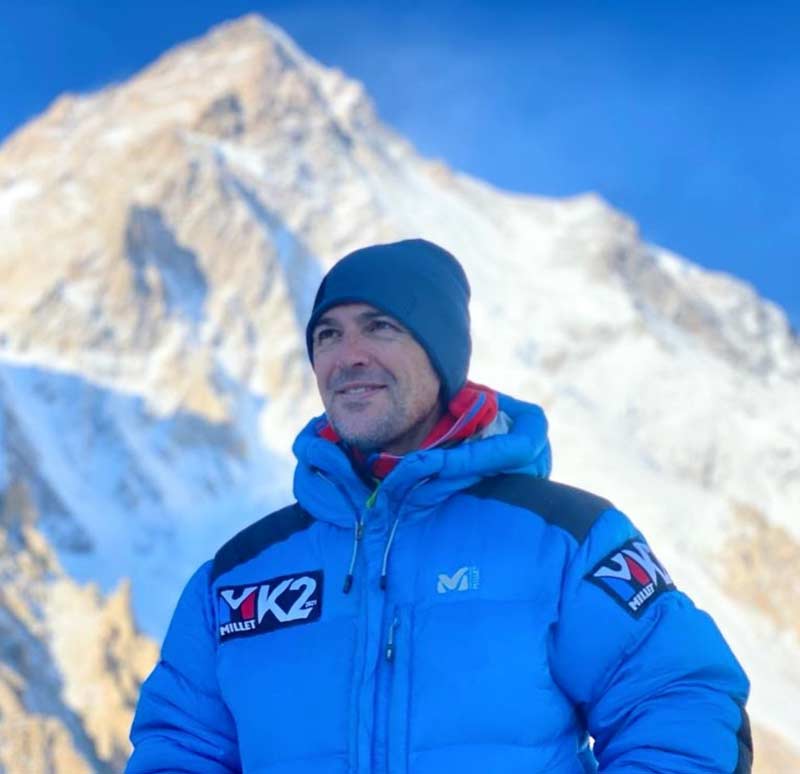The K2 was climbed for the first time in winter. But while the summiteers were cheering, one of their colleagues died further down the mountain, who had turned back out of caution that morning.
The message of triumph came via Instagram: “We did it!” Wrote Chhang Dawa Sherpa. Yesterday, Saturday, at 16:58 p.m. local time, ten Nepalese stood on the summit of K2. They had used a favorable weather window and achieved what many had thought unthinkable the day before. Chhang Dawa added: “It's K2 and it's winter. Let's hope that everyone returns to the base camp in good health. " A little later he had to spread news of his death: the Spaniard Sergi Mingote, who had decided not to attempt the summit at the last moment, had crashed on the descent. A rescue group could only rescue him dead.
The Spaniard Sergi Mingote, who had skipped the summit at the last moment, had crashed on the descent.
Alpinists like to humanize the mountains they approach. The mountain calls, checks, gives to understand ... Or it flexes its muscles. This is how it could be interpreted what happened last week when the first high camps on the Abruzzi route were swept away at K2. The tents and their valuable equipment - sleeping bags, spare clothes, cooking utensils, oxygen bottles - all blown with the wind while the climbers were back in base camp. As if the K2 had discovered an annoying mosquito on its shoulder and wiped it away.
The tents with their valuable equipment - everything blown with the wind.
As the only one of the fourteen 8000ers, the K2 stubbornly resisted a winter ascent. At 8611 meters, it is only 200 meters deeper than Mount Everest - but far more difficult to climb. In contrast to Everest, there are hardly any flat passages, and there is no objectively safe route either. The most frequent ascent leads over the southeast ridge, the so-called Abruzzi spur.

After about 3000 meters of difficult climbing, the mountaineers reach the somewhat flatter shoulder of the mountain over snow and ice flanks interspersed with rocks. The most dangerous place waits at the very end, the so-called «bottleneck». The only way to the summit is through a steep couloir below a threatening hanging glacier. In 2008, eleven climbers died at this point after an ice break. The K2 has the second highest death rate after Annapurna: According to statistics, the probability of not surviving the mountain is one in four.
An inhumane climate
In view of the high technical climbing difficulties and the demanding weather conditions, it is not surprising that it took so long before the winter ascent of K2 was successful. It has been tried several times since 1987: Seven teams, mainly Russians and Poles, who made a name for themselves as "ice warriors" with winter climbs, failed.
Seven teams, mostly Russians and Poles, who made a name for themselves as "ice warriors" with winter climbs, failed.
In 2003 the Russian Denis Urubko and the Pole Marcin Kaczkan reached 7650 meters. No one made it higher up to this year. Temperatures of minus 40 degrees must be expected at the summit. Depending on the weather, the K2 touches the jet stream, which leads to turbulence that can be felt as strong winds deep into the flanks. Then there are avalanches that loosen high above.
While the 8000ers are overrun in spring and summer, there is calm in winter: expeditions take place on a small scale, there are no Sherpas pre-set slopes to the summit, the climbers are largely responsible for themselves. Despite the much more difficult circumstances, bottled oxygen was dispensed with on all initial winter climbs with the exception of Mount Everest. The "clean style" is an unwritten law.
Despite the much more difficult circumstances, bottled oxygen was dispensed with on all initial winter climbs with the exception of Mount Everest.
This year, the base camp at the foot of the K2 is filled with around sixty people - a surprising rush of the kind that has only been known here in the summer season. “On the one hand, it is of course due to the fact that the winter ascent of the K2 is practically the last major problem in 8000m mountaineering that needs to be solved. Whoever manages it will go down in the history books, ”said Stefan Nestler, journalist and mountaineer, who has been following high-altitude mountaineering at close range for more than twenty years, said last week. It is no coincidence that two Nepalese teams are on the mountain. “Mountain climbing is part of the national pride of Nepal, and there it is a shortcoming that the Nepalese actually played no role in the previous winter ascents of the thirteen other 8000ers. The K2 is the last chance to correct that. "
Mountain climbing is part of the national pride of Nepal.
Stephen Nestler
The ascent was celebrated with euphoria. This is one of the greatest moments in the history of alpinism, the team announced on social networks. It is thanks to good teamwork and the fact that the mountain has shown itself to be friendly. "If the mountain wants, nobody can stop you," wrote Chhang Dawa. In the evening it was announced that all ten climbers had arrived safely in Camp 3 at 7350 meters.

The top Nepalese teams weren't the main reason why the base camp was as full in December as it usually is in summer. The agency Seven Summit Treks (SST), the largest Nepalese provider of high-altitude mountaineering tourism, also moved into quarters with a group of summit aspirants. A novelty. With its low-price strategy, the company leads around 500 customers every year to the various 8000-meter peaks, and another 1200 to deeper mountains or trekking tours. This makes SST the largest company in Nepal, the agency creates 2000 jobs.
This makes Seven Summit Treks the largest company in Nepal, the agency creates 2000 jobs.
SST is regarded as the most important taxpayer in Nepal as well as being influential. The founders are Sherpas who once worked as porters themselves, two of them, Mingma and Chhang Dawa Sherpa, have now climbed all fourteen 8000ers. They make no secret of their business model: The high mountains should be accessible at low prices, there is talk of the democratization of the mountains - now also in winter. The current expedition to the K2 was offered for sale on the website in the same way as a coach trip to Venice: "Book this trip." SST has brought 22 customers to the K2 base camp, whose experience and skills vary considerably. There are professionals, but also experienced hobby mountaineers. The Swiss Josette Vallotton has five 8000ers, other participants zero.
When I asked the founders that they had the highest death rate among commercial providers, the answer was: "We also have the most customers."
Stephen Nestler
Given these conditions, the risk of someone having an accident was great from the start. When asked whether the company could afford this damage to its image, Stefan Nestler says: “They already don't have the best reputation, and yet the business model works. You take a rather fatalistic stance, in the sense of: We are in the 21st century. People know what they are getting into. When I once asked the founders that they had the highest death rate among commercial providers, the answer was: ‹We also have the most customers.› »
Impossible without oxygen?
The irony of fate is that Sergi Mingote, of all people, left his life at K2. The 50-year-old Spaniard had been hired by the SST company to lead their expedition, he had climbed the K2018 in the summer of 2 and was considered an expert on 8000 m peaks. According to the newspaper “Marca”, he wanted to make the winter ascent without oxygen. When he sensed on the morning of the summit attempt that his strength would not be sufficient, he turned back. But he never made it to the base camp. It is questionable whether the SST expedition will now be continued.
It is questionable whether the SST expedition will now be continued.
Shortly before the successful winter ascent, the specialist journalist Nestler said that he considered it realistic that one of the Nepalese teams could make it to the summit. "But I dare to doubt that they will go to the summit without oxygen, as has been announced in some cases." He was addressing a topic that was hotly debated among extreme mountaineers. Can the first ascent of K2 in winter break with the tradition of clean style? At the northernmost point of the 8000ers, the atmospheric pressure is lower, so the air is even thinner. It is therefore not clear whether the oxygen saturation is sufficient to ascend without a bottle. Perhaps that will be clarified when the Nepalese announce how exactly they made the ascent to the summit of K2.
The K2 is very difficult to climb. There are hardly any flat passages and no objectively safe route to the 8611 meter high summit.

Sergio Mingote
The Spaniard, who died on Saturday on K2, was considered an expert on the highest peaks. In 2001 he was the first to climb the north face of Mount Everest solo. Mingote wanted to conquer all 2019 eight-thousanders within 20 days without artificial oxygen in 14/1000, but he had to stop the project because of Corona. That was the reason why he signed up for the fatal winter expedition to K2.
That might interest you
+ + +
Credits: Text Dominik Osswald, cover photo Kuno Lechner CC BY-SA 3.0, Picture bottleneck Rolf Zemp - CC BY-SA 3.0

